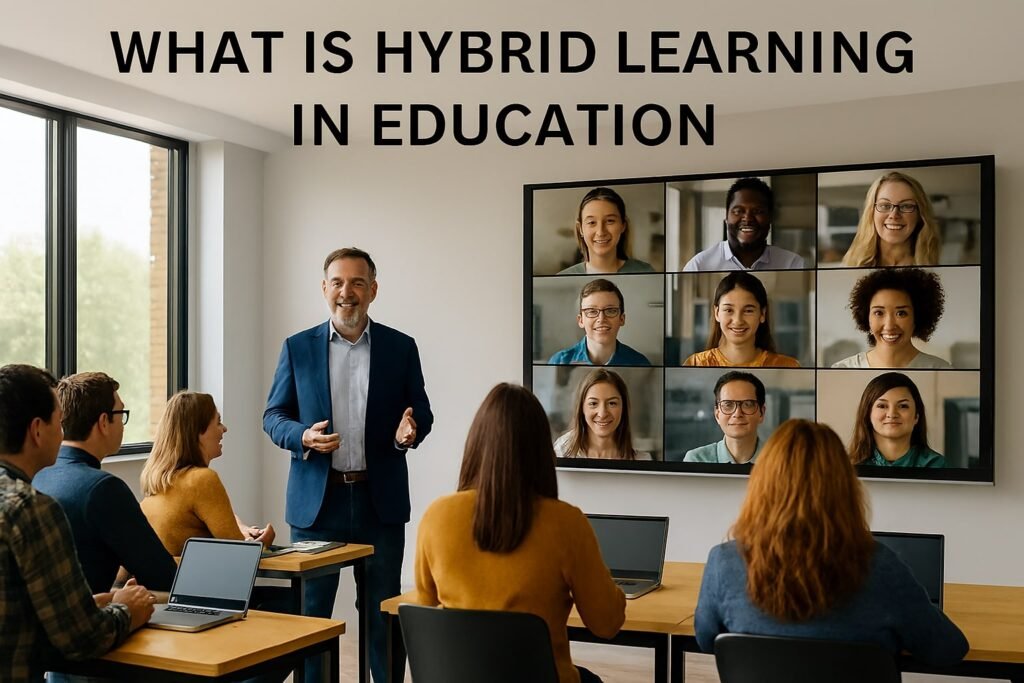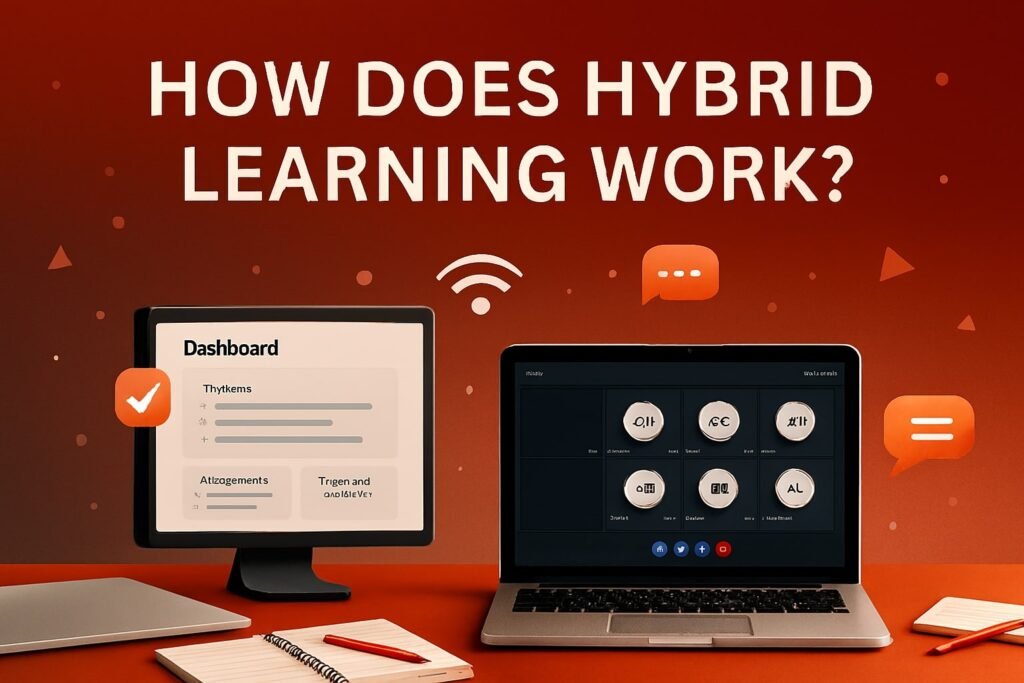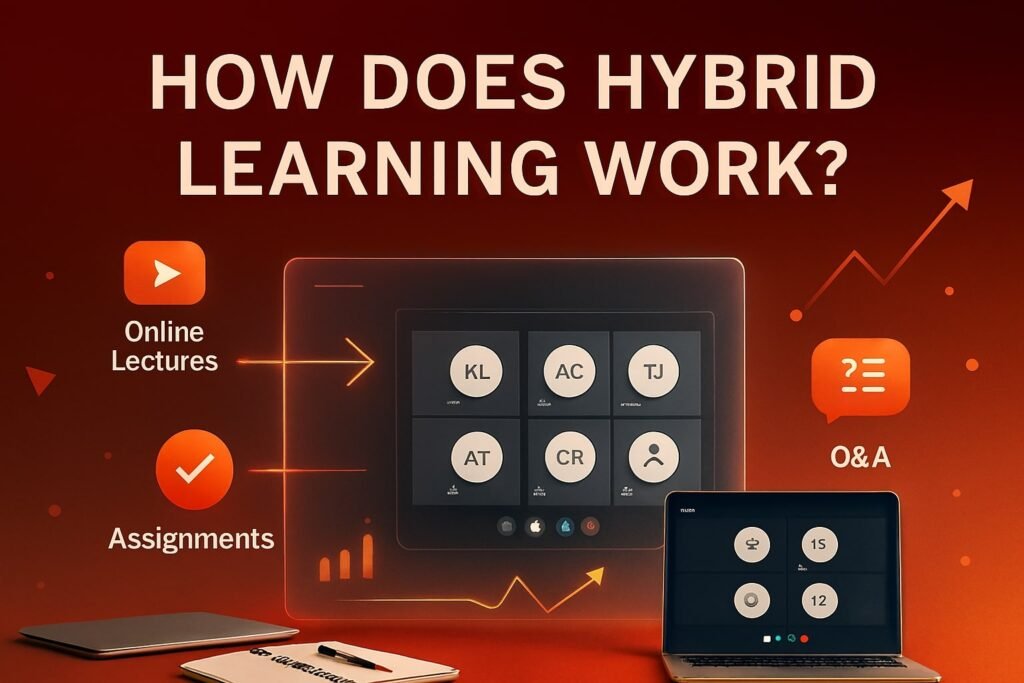Hybrid learning in education is a way of teaching that mixes classroom lessons with online learning. It is also called blended learning. Students enjoy the best of both worlds: direct contact with teachers and the freedom of digital tools.
This article explains what hybrid learning means, how it works, its main benefits, its challenges, and why many people see it as one of the most effective methods in education today.
What Is Hybrid Learning in Education?
Hybrid learning in education is a model where teachers mix online lessons with classroom teaching.
In class, students talk and work with teachers and peers.
Online, they use tools like a Learning Management System (LMS), video lessons, and short quizzes.
This method gives students more freedom but still keeps structure. Many schools and universities adopted hybrid learning during the COVID-19 pandemic. It is still growing because it makes learning easier and more engaging.
How Does Hybrid Learning Work?
Hybrid learning works by balancing synchronous and asynchronous learning methods.
- Synchronous learning: Real-time classes using tools like Google Meet or Zoom.
- Asynchronous learning: Self-paced study through recorded videos, assignments, and notes on an LMS like Google Classroom.
Example Scenario
- A teacher gives a lecture in the classroom.
- The same lecture is uploaded on Google Classroom for students who missed it.
- Students join a Q&A session on Google Meet for clarification.
- Assignments are submitted online, reducing paperwork.

Role of Learning Management System (LMS)
A Learning Management System (LMS) is the backbone of hybrid education.
- It delivers study materials.
- Stores recorded lectures.
- Hosts quizzes and assignments.
- Tracks student progress.
Example:
- Google Classroom is one of the most widely used LMS platforms.
- Teachers can post notes, assignments, and quizzes.
- Students can access them anytime, anywhere.
Advantages of Hybrid Learning
Hybrid learning is becoming popular because it offers flexibility, engagement, and cost savings.
What I Like About Hybrid Learning
- Active Learning: Students can rewatch lectures, engage in discussions, and do self-assessment.
- Flexibility: Fits into busy schedules, useful for working students.
- Reduced Transportation Costs: Saves money and time by reducing daily travel.
- Better Engagement: Mix of face-to-face and online methods keeps learning interactive.
- Accessibility: Students from remote areas can still join online.

Disadvantages of Hybrid Learning
Like any model, hybrid learning has challenges.
Areas for Improvement
- Low Participation: Some students may avoid engaging in online discussions.
- Technology Issues: Slow internet or device problems disrupt learning.
- Time Management Problems: Students may procrastinate if not disciplined.
- Unequal Access: Not all students have access to laptops or stable internet.
Hybrid Learning vs Traditional Classroom Instruction
| Feature | Hybrid Learning | Traditional Classroom Instruction |
|---|---|---|
| Flexibility | High – Online + Offline | Low – Fixed schedule |
| Cost | Lower (saves transportation costs) | Higher (daily travel, physical resources) |
| Engagement | Active learning methods | Mostly lecture-based |
| Accessibility | Students can join remotely | Limited to physical presence |
Why Hybrid Learning Is Effective
Hybrid learning is considered one of the most effective models because:
- It combines the best of online and in-person methods.
- It is student-centered, encouraging independence.
- It supports 21st-century skills like problem-solving, self-learning, and critical thinking.
- Research by the U.S. Department of Education shows blended learning students perform better than purely traditional learners.
Real-Life Experience and Use Cases
- Universities: Many global universities use hybrid learning for higher education. For example, MIT offers hybrid courses with online lectures and in-person labs.
- Schools: During the pandemic, schools used Google Classroom and Google Meet to continue lessons.
- Corporate Training: Companies train employees using hybrid learning, mixing workshops with online modules.
FAQ Section
1. What is hybrid learning in simple words?
Hybrid learning means studying both in the classroom and online.
2. Is hybrid learning better than traditional learning?
Yes, because it combines the strengths of both models: interaction + flexibility.
3. What tools are used in hybrid learning?
LMS platforms like Google Classroom, and video tools like Google Meet or Zoom.
4. What are the disadvantages of hybrid learning?
Tech issues, time management problems, and unequal access to devices.
5. How does hybrid learning save money?
It reduces transportation costs and cuts down on paper materials.
6. Who benefits most from hybrid learning?
Students with busy schedules, remote learners, and working professionals.
7. Is hybrid learning the future of education?
Yes, because it adapts to modern needs and technology-driven lifestyles.
Conclusion
Hybrid learning in education is a powerful model that blends traditional classroom instruction with digital learning tools. It is flexible, cost-effective, and engaging, though challenges like technology issues and participation gaps must be addressed.
Author Bio
Dr. Farid Ahmmad, PhD is a researcher and educator specializing in hybrid learning, Learning Management Systems (LMS), and blended education models. He has published studies on how universities in Bangladesh adapted synchronous and asynchronous learning during and after COVID-19. Currently, he works as an educational consultant, helping institutions design effective hybrid learning strategies.
References
- U.S. Department of Education – Evaluation of Evidence-Based Practices in Online Learning
- Educause Review – The Future of Hybrid Learning
- Google for Education – Google Classroom & Google Meet Usage Reports


